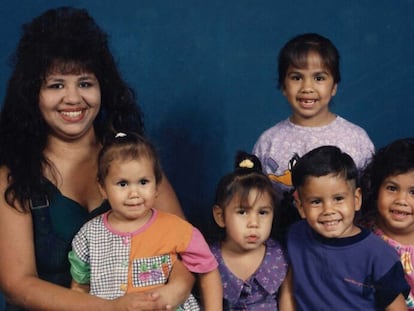On death row with Keith LaMar, the prisoner who was brought back to life by jazz: ‘I’m not ready to die’
He’s been awaiting execution for almost three decades for crimes that he says he didn’t commit. From a maximum security prison in Ohio, he details his fight to reopen his case and his unusual musical project with Spanish pianist Albert Marquès — a cry of protest against capital punishment in the United States

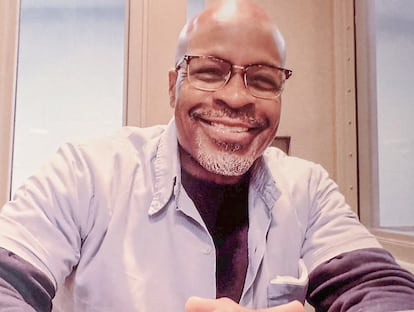
Keith LaMar — imprisoned on death row since 1995 — hasn’t seen the sky for six months. He’s allowed to go out every day to a small patio, closed with concrete walls on all four sides with holes in the roof. This allows him to receive the limited amount of fresh air he is authorized to breathe. Rain or shine, guards at the Ohio State Penitentiary sometimes forget to come back for him. Last time, he asked to go out six days in a row. Sometimes, he blames himself for not doing it more often.
LaMar has been in one of the most feared maximum security prisons in America for the past 25 years. He’s serving his sentence in solitary confinement as an extra punishment for a crime that he claims he didn’t commit: participating in the murder of five inmates during the first hours of the 11-day-long Lucasville prison riot, in 1993. This was the longest prison uprising in American history.
In 1998, he was transferred to this prison, which, at the time, was newly-built. He spends 22 hours a day in his cell, which measures 126 square feet. The rest of the time, the guards take him out to a larger room, where he walks, goes up and down stairs, and does push-ups and pull-ups. He doesn’t share that time with anyone else, either.
The authorities allow him to talk on the phone for eight hours a day and — for a few months now — send text messages. He can also receive visitors. In mid-October, he accepted an interview with EL PAÍS, which ultimately lasted four hours. He was seated across from the reporter in one of those booths that you see in the movies, separated by bulletproof glass. That Wednesday, the rest of the visitor rooms were empty.
He arrives escorted by two officials, with handcuffs on his hands — which were removed — and shackles on his feet. At 54-years-old, he’s a big man, standing over 6 ft 2. He clearly stays in shape. On his way to and from the interview, the guards subject him to a humiliating physical examination. “Those guys always try to break you, to strip you of your dignity,” he says after a while.
He’s wearing a thick sweatshirt and a long-sleeved T-shirt under the blue prison uniform. He explains that it can get really cold in the facility (something that’s confirmed as the time passes). Visitors are forced to leave their jackets outside. You’re only allowed to enter with a form of ID and a credit card, which you can use at the expensive junk food machines. This helps keep the big business of mass incarceration in the United States going, with $180 billion moving through the sector on an annual basis.
Due to the strict regulations, the interview couldn’t be recorded. Notes had to be taken on a piece of paper, with a pen borrowed from one of the two jailers on duty, who passed the time watching court TV. The interview was then completed this past Friday via telephone. Ohio also prohibits photographers from entering death row facilities, but a prison official is permitted to take a photo at the end of the encounter with an old digital camera.
LaMar’s execution had been scheduled for November 16 by the state of Ohio. However, this past July, Republican Governor Mike DeWine granted him a reprieve until January 2027. LaMar calls it “a borrowed time.” “In here, we’re human beings pushed to the brink. But I’m not ready to die.” During his interview, he speaks eloquently, peppering his answers with references to thinkers, activists and poets, from Primo Levi to Malcolm X.
The extension isn’t simply an act of clemency. For five years, Ohio — one of the 27 states in which capital punishment is applied — hasn’t killed any of the 130 men it has on death row. This is because pharmaceutical companies refuse to sell the authorities the drugs required for lethal injections. LaMar recently received an official letter asking him to choose his preferred alternative: electric chair, hanging, firing squad, guillotine, or gas chamber. During our talk, when asked if he had answered that letter and which method he would prefer, he responded: “I don’t want to participate in that macabre game. I would prefer to die in my sleep or, better yet, in bed with a woman.”
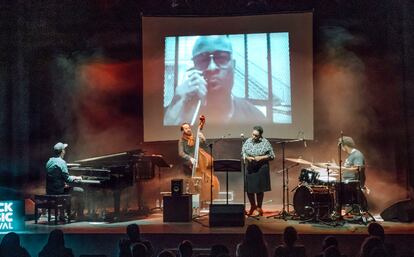
To celebrate the “triumph of staying alive,” LaMar will release — on the day that Ohio planned to assassinate him — a song with the Spanish jazz pianist Albert Marquès. It’s titled The Journey, recorded with some of the best improvisers from the New York scene. The lyrics tell the story of how the 37-year-old musician and LaMar began collaborating during the pandemic — shortly after the murder of George Floyd — on a project called Freedom First. Over the phone from the hallway of death row, LaMar recites over the tonalities of contemporary jazz. Most of the lyrics are his own: some are memories of his life before and after prison, while others are cries of protest against capital punishment. In one song, he recites a line by the Turkish poet Nâzim Hikmet: “Living is no laughing matter / You must take it seriously.”
Last year, they recorded an album, which was presented live on dozens of stages on both sides of the Atlantic. Marquès has also just published a book — Jazz from Death Row — in which he writes about the relationship forged between himself and LaMar through music.
It’s a mixture of LaMar’s biography, the pianist’s personal memory and an examination of the American prison system from the point of view of a foreigner. Marquès — who hails from Catalonia — is married to an American and is the father of two American children, in a country that is often brutal and not always easy to understand.
When they perform together, he “enters” the shot from his cell. He crouches between the toilet and the wall — “where there’s better signal” — and tries to keep up with the performance. “It’s not easy, because all I get is a confusing noise,” he confesses. The French embassy in Washington held the show on October 10, to raise awareness about the death penalty. A woman’s metallic voice announced: “This call is coming from a correctional facility in Ohio and may be recorded and monitored.” After a while, the connection was cut. LaMar dialed again from the prison. Marquès — still playing — answered the phone.
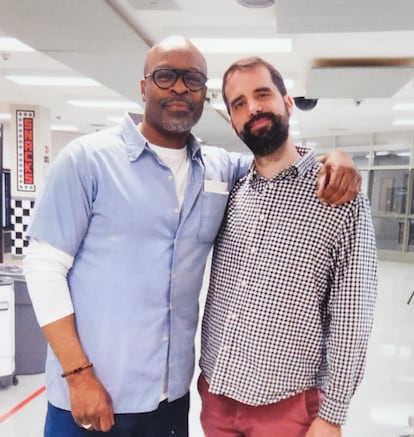
The pianist and activist — who has been living in New York for a decade — explains to EL PAÍS via video call from the school in Manhattan where he teaches children that technical setbacks are common. He’s learned to manage them without losing his flow.
Marquès learned about LaMar’s case for the first time thanks to Brian Jackson, a musician who shared a story in Mother Jones magazine, which — at the beginning of the pandemic — asked him for recommendations on how to cope with confinement. LaMar talked about jazz and how saxophonist John Coltrane had saved his life. “I left high school when I was 16, but being here (in prison) has been a valuable education for me. Thanks to music and literature,” LaMar clarified, in his interview with EL PAÍS, “I no longer felt like I was serving my sentence waiting for time to pass. For the first time, I was taking advantage of it. I lived my life. I took the reins: literature and writing became a way of fighting. This has allowed me to maintain my sanity.”
The Lucasville prison riot
LaMar has been behind bars since he was 19 years old. Back then, he was a dealer in Cleveland, during the crack epidemic. One day, he killed an addict — a childhood friend — when the man entered his apartment to rob him. LaMar also got shot twice. “I didn’t know it then, but I wasn’t happy, even though I had lots of money and drove a Mercedes. I was lost. I lived in another form of prison,” he recalls. He was sentenced to 18 years to life in prison. After some time, they sent him to the Lucasville prison, in southern Ohio. Overcrowded and extremely violent, it was a powder keg ready to explode.
The prison blew up four years later, in 1993, when the warden wanted to force Muslim inmates to undergo a tuberculosis test, which included the injection of a serum that contained alcohol, a substance incompatible with their religion. That was the spark, and on Easter Sunday that year, a riot broke out. A strange alliance was formed: the white supremacists of the Aryan Brotherhood and the Black Gangster Disciples. They took control of module L-6, the cellblock where LaMar was imprisoned.
According to his story, the big mistake was insisting on going to look for his few belongings to keep them safe. When the riot police entered, he was back in the yard: they took him and hundreds of other prisoners to the next cellblock, where they were stripped naked and locked up into tiny cells. In LaMar’s section, tensions grew until, the next day, one guy killed another.
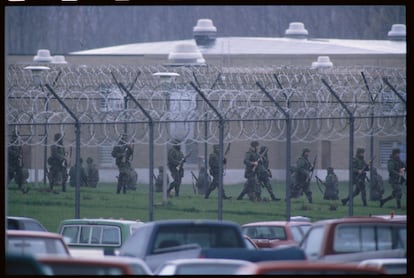
This was one of the five murders that would be attributed to him (not as the perpetrator, but as the instigator). They also accused him of leading a “death squad” that — as the prosecution maintained at trial — murdered four other “snitches” in those first hours of the riot. The riot — which saw eight guards taken hostage and prisoner control over cellblock L-6 maintained for 11 days — was broadcast on television throughout the country. Ten people died in all: nine inmates and correctional officer Robert Vallandingham. In the end, they surrendered with the commitment that there would be no retaliation.
The revolt — which, years later, inspired a Netflix documentary — made such an impression on public opinion that the authorities quickly wanted to find the culprits and administer swift justice. They sent five people to death row: four inmates who were rioting the entire time — all of whom were prominent members of the factions involved — and LaMar, who was not part of any of those groups. They were dubbed the “Lucasville Five” — a term he doesn’t like to be associated with.
“Someone had to pay… and that was me,” he sighs, 30 years later. “They allowed the riot to happen to justify an investment of $50 million in a maximum security prison. As Noam Chomsky says, the best way to know what something was about is to look to see what changes it introduced..
Poverty and unemployment
The Ohio State Penitentiary is what is known as a “supermax prison,” where the most dangerous inmates are locked up in solitary confinement. It holds 500 men, but only LaMar and the others from Lucasville are on death row. Except for one of them — who was transferred for mental health reasons — they have never left the facility since it was inaugurated in 1998.
It’s in Youngstown, one of those small American towns in the middle of nowhere, where the future seems like a thing of the past. With a poverty rate of 35%, it depends largely on the supermax — one of the most generous employer in the area. It’s part of a kind of lifeline that the Ohio government threw to its residents with the disappearance of the steel industry, the end of which left behind a landscape of abandoned factories.
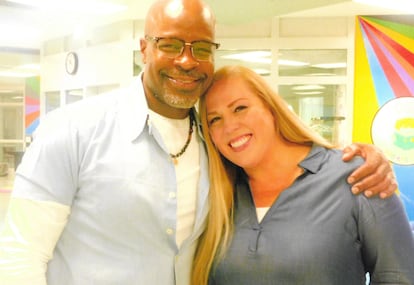
The night before the scheduled interview at the jail — a creepy, flat mass with hardly any windows — EL PAÍS met with Amy Gordiejew in a restaurant on the outskirts of Youngstown. She’s an English teacher for migrant children and has been leading the Justice for Keith LaMar campaign for the past decade. “It’s not that I believe Keith is innocent: it’s that I have absolutely no doubt about it.” With even more confidence, she adds, after the second season of the popular true-crime podcast The Real Killer was released. In season two, episode six, a journalist discusses the blind spots in the trial that sent LaMar to death row — part of a process that was “riddled with irregularities.”
“22,000 pieces of evidence were collected from the crime scene and none of it could be linked to him,” Gordiejew emphasizes, adding that prosecutors hid “mountains of exculpatory evidence,” such as statements made by Anthony Walker. At one point, Walker claimed that he didn’t even see LaMar that day in cellblock L-6… before ultimately pointing the finger at him and singling him out as the leader of the squad that killed snitches. For Gordiejew, this shows how Walker was getting reduced penalties as he changed his statements. In the United States, the prosecution is obliged to share this kind of information with the defense under the Brady rule, established in the 1960s by a historic Supreme Court ruling.
The case was built based on the testimonies of inmates who were offered benefits in exchange. LaMar notes that he was also tempted by this, but he didn’t want to get into that game. The defense recommended that he plead guilty: if he had done so, he wouldn’t have been sentenced to death. He would have been spared three decades of isolation and — judging by his good behavior — he would most likely have been free a long time ago. But he refused. “I have no regrets,” he clarifies. “Otherwise, I would have become a confessed mass murderer. I would have had to live with it for the rest of my life, the same way I live with the fact that I killed a man.”
Finally, an all-white jury convicted him. The judge gave him the maximum sentence. LaMar says he was a victim of a system in which 90% of inmates end up behind bars after pleading guilty, whether they’re guilty or not: “They had bazookas, we had slingshots. The job of those prosecutors was to get a guilty verdict, not to do justice.”
Seth Tieger — one of the prosecutors who sent him to prison in 1995 — told The New York Times last year that he still considers LaMar “extremely guilty. He’s where he belongs: on death row.” Over three decades, the inmate has exhausted all appeals and, in all of them, the court has confirmed Tieger’s conclusions.
LaMar details this judicial ordeal in Condemned: The Whole Story, the self-published memoir that he released in 2014. Those who defend his innocence have translated the book into three languages, including Spanish. He wrote it with the help of Gordiejew: he dictated the text over the phone to her every morning and at other points during the day. “It was an arduous process,” she remembers. “And expensive. The calls — which could be a maximum of 15 minutes — cost $1 each. And we did hundreds and hundreds of hours”
LaMar has a copy in the small library in his cell. He proudly says that he keeps it “between two books by James Baldwin and Richard Wright.” It wasn’t always like this, though. As part of the extreme punishment imposed on him, he wasn’t only kept in isolation, but, for a time, he was prohibited from having records or books. He also wasn’t allowed physical contact with relatives during visits… a right that he ended up gaining by going on several hunger strikes, inspired by the example of IRA member Bobby Sands.
“The first thing they give you when you get to death row is a television,” LaMar explains. “It’s like a cruel window to the outside world. You can stare at it all day and live your life through it. You don’t have to think. I refused that.” He tries to watch only PBS and spends the bulk of his time reading, listening to music with headphones and writing between two and six in the morning “when the prison is quiet.”
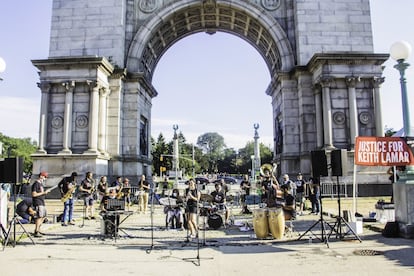
LaMar discovered jazz at the age of 25, thanks to an inmate named Snoop. Before that, since he was a teenager, he had listened mainly to soul music: Stevie Wonder, Curtis Mayfield, Luther Vandross... but with his introduction to jazz, he started with Coltrane. Then came Miles Davis, Thelonious Monk, Keith Jarrett and Joe Henderson. “The albums of these geniuses are like galaxies,” he smiles. “In those compositions, full of nuances, of frequencies, is all the complexity of the African-American experience.”
Marquès had the idea for him to recite his poems over the music. “I encouraged him, because I think he’s a good writer,” the pianist says. He also asked him to make a list of 10 songs to start working on the project. They connected right away. “People are surprised that a guy from Grenollers [near Barcelona] and a Black man from Ohio can understand each other, but for me, he’s already a friend, like a brother,” Marquès affirms. He is also convinced of LaMar’s innocence.
“They ask me a lot about how this [friendship] happened,” LaMar notes. “It’s key that Albert wasn’t born in the United States. He hasn’t grown up with the preconceived notion that a poor Black man is only capable of terrible things, never anything sublime. For me, jazz has been like a Trojan horse: it has allowed me to bring my story to more people through music, which then became a bridge. [I’ve reached] people who aren’t necessarily thinking about capital punishment.” About 75 musicians have participated in the project, most of them without pay. The profits obtained from the album are directed to the campaign for LaMar’s release. Half of the proceeds from Marquès’ book sales will also go towards this endeavor.
The jazz adventure has helped raise the public profile of the case, catching the attention of a civil rights attorney named Keegan Stephan. After reading LaMar’s book, he went to New York to attend one of Freedom First’s concerts. He became involved in the defense, which, in recent months, has been joined by a powerful law firm that is offering its services for free. The attorneys are reviewing tons of legal documents, also based on the findings from The Real Killer podcast.
Although he’s exhausted all possible appeals, LaMar is hopeful that the case can be reopened. “It’s the first time in 30 years that I’m playing with all the cards. In this country, you have no opportunity if you don’t have money.” The public defenders who represented him in the 1990s barely charged $100 an hour. Paying those who are helping him today (pro bono) would cost hundreds of thousands.
When asked why he believes that the state of Ohio has kept him waiting for his final hour for almost thirty years, LaMar answers: “They’re like vultures. They want to harvest every last piece of your flesh. It’s like a modern lynching. And an empty cell only means one thing to them: that they’re losing money.”
He says he feels lucky to have achieved a tight support network that other inmates — whom no one calls or goes to see — don’t have. He receives about three visitors a week and is constantly in contact with the outside world. More than anything, this is because of the support of friends and his campaign who help pay for his phone bill, which can run up to $16 per day.
“The guards don’t understand why I generate so much interest. They look at me as if to say: ‘What’s up? You think you’re someone important?’ And I know I am somebody. It doesn’t enter into their calculations that you can overcome this shitty life,” he says. He fears that the postponement of his execution is causing irritation, to the point that, a few months ago, he began to suspect that the guards were putting something in his food… something that was causing him severe dizziness. All kinds of medical analyses were done and “by the deductive method” he came to the conclusion that there could be no other explanation. “I know it sounds crazy. I’m the first one who has to be alert to any sign of losing my mind, but there simply wasn’t a reason [for this].” The dizziness disappeared after he began to feed himself with the food he bought at the commissary. His visitors also buy him sandwiches.
At the end of our conversation, I asked him: What is the first thing he plans to do if he is finally released? “Many things,” he responds. “I’d go to a jazz festival. Maybe the one in San Sebastián (Spain). I’ve never seen a jazz concert. I haven’t flown on a plane, either. But above all, I’d continue taking my life seriously. I learned to do it too late.”
Sign up for our weekly newsletter to get more English-language news coverage from EL PAÍS USA Edition
Tu suscripción se está usando en otro dispositivo
¿Quieres añadir otro usuario a tu suscripción?
Si continúas leyendo en este dispositivo, no se podrá leer en el otro.
FlechaTu suscripción se está usando en otro dispositivo y solo puedes acceder a EL PAÍS desde un dispositivo a la vez.
Si quieres compartir tu cuenta, cambia tu suscripción a la modalidad Premium, así podrás añadir otro usuario. Cada uno accederá con su propia cuenta de email, lo que os permitirá personalizar vuestra experiencia en EL PAÍS.
¿Tienes una suscripción de empresa? Accede aquí para contratar más cuentas.
En el caso de no saber quién está usando tu cuenta, te recomendamos cambiar tu contraseña aquí.
Si decides continuar compartiendo tu cuenta, este mensaje se mostrará en tu dispositivo y en el de la otra persona que está usando tu cuenta de forma indefinida, afectando a tu experiencia de lectura. Puedes consultar aquí los términos y condiciones de la suscripción digital.
More information
Archived In
Últimas noticias
Most viewed
- Sinaloa Cartel war is taking its toll on Los Chapitos
- Oona Chaplin: ‘I told James Cameron that I was living in a treehouse and starting a permaculture project with a friend’
- Reinhard Genzel, Nobel laureate in physics: ‘One-minute videos will never give you the truth’
- Why the price of coffee has skyrocketed: from Brazilian plantations to specialty coffee houses
- Silver prices are going crazy: This is what’s fueling the rally
